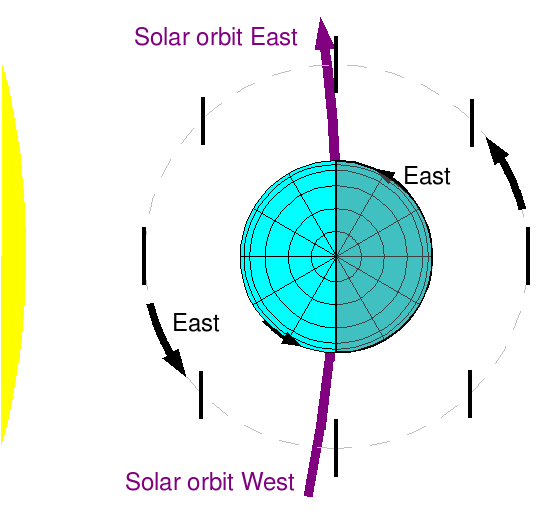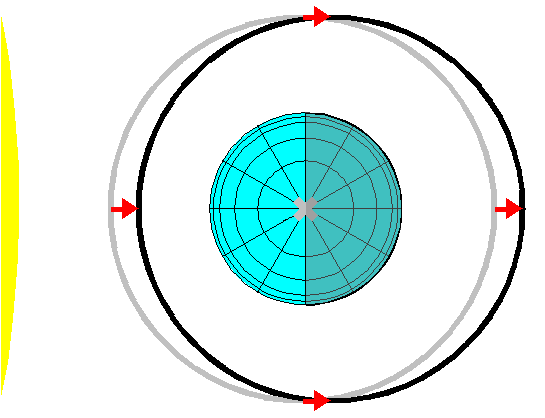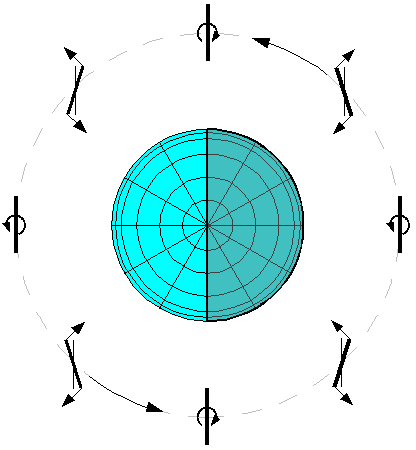Thinsat propulsion, navigation, and orientation
MoreLater - update for a 80 micron, 5 gram V4 thinsat with albedo 0.25 to 1.0 thrusters, 5 to 8 μPa .
A thinsat is light enough to be significantly accelerated by light pressure. At the earth's distance from the sun, the illumination is 1300 Watts per square meter, on average. The light pressure for absorbed light is the power divided by the speed of light, or about 4.5E-6 N/m2 or 4.5 microPascal. If the light is reflected, the pressure doubles to 9 microPascal. This is a tiny pressure (sea level atmospheric pressure is 100 kiloPascals) but it is continuous. When pushing on something as thin and light as a thinsat, it can add significant velocity over hours, weeks, and years. The areal density of an 80 micron thick thinsat is 0.2kg/m2 , and the albedo of a solar cell is around 0.25, so the acceleration is 1.25x4.5e-6/0.2 or approximately 28 micrometers/second2, or 10 centimeters/minute2, or 360 meters/hour2.
The thrusters change the albedo by about 3 μPa over an area of 60 square centimeters. If thruster albedo changes by 3 μPa, the thrust change is 18 nanonewtons, and the related acceleration difference is 3.5μm/s2. That allows for significant local maneuvering.
Large orbital changes are harder. Thinsats are in orbit, and if they are pointed directly at the sun, they are accelerated directly away from it. That adds to orbital velocity as their orbit takes them away from the sun, but subtracts from orbital velocity as they approach it. If they are tilted in relation to the sun, less area is exposed to light pressure, and the "albedo vector" of reflected light is tilted also, which can add a small sideways thrust.
|
Defining directions |
Thinsats will get the most power if they face directly into the sun. However, they tilt to manuever. and that reduces the thrust. If they are tilted 45 degrees sideways, they get 30% less light and must reduce computing and radio functions, but they will still operate. With a 60 degree tilt, they get half power (and they cool down a lot!). Infrared light from the earth is mostly absorbed by the thinsat, and that creates some light pressure, too.
|
Shifting the orbit center to compensate for light pressure |
Light pressure from Optical thrusters
The version 1 design has three round liquid crystal light pressure thrusters at 120 degree angles around the periphery. These are either black or transparent. They are 5cm in diameter (about 2 inches), and have areas of 2e-3 m^2. When reflecting, an ideal thruster produces perhaps 16 nano-Newtons, and when transparent it produces zero. Real materials will always show some reflection in transparent mode, and some transparency in reflective mode . Also, radiation from the earth (both albedo and infrared) reduces the effective thrust. So, the thrust may vary between 12nN and 4nN (WAG). If one thruster on one side is fully reflective, while the other two are clear, the thrusters together produce a torque of 8nN times 10 cm or 800 pico-Newton-meters. If the entire thinsat has a mass of 0.007kg and an average diameter of 8 cm, the angular acceleration is 70 micro-radians per second squared. Accelerating for 36 seconds, then decelerating (applying opposite acceleration) for 36 seconds, will turn the array 10 degrees. Accelerating for 90 seconds, then decelerating for 90 seconds, turns the array approximately 60 degrees (not quite, as the thrusters are moving out of plane and become less effective when turned away from the sun).
Here is an animation of a thinsat turning with an angular acceleration of 14 degrees per minute squared ( 70 micro-radians per second squared), for a 56 degree turn in 240 seconds. If your browser renders this animated PNG movie at full speed, it should be running at 10 frames per second, each frame representing 2 seconds, for a 20x speedup over real time. The animation will repeat after 12 seconds.
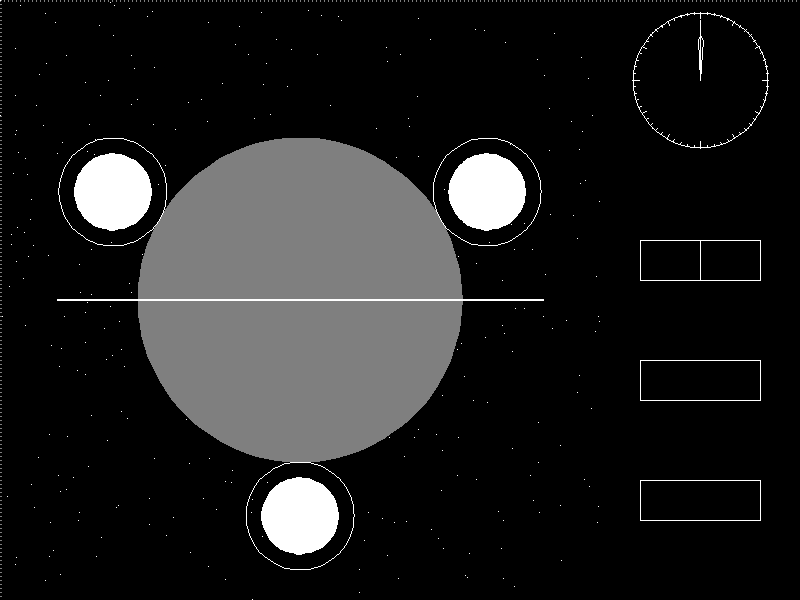
Here is the source , and you will need libGD and apngasm
This is an ancient drawing. Version 4 thinsat elecrochromic thrusters vary between reflective and dark/opaque. They are also square, not "mickey" shaped. See V4thinsat for recent information I will update this drawing Real Soon Now.
Recovering from a spin
Imagine some perturbation like a collision starts the thinsat spinning end over end at 1 revolution per second. Assume that the processors and memory and transmitters go into low power standby mode when this happens, so that power remains for the receivers (for orientation) and for the optical thrusters. Back side solar cell will produce a trickle of power.
The spin is very slow in "computer time" - the thinsat should be able to orient to the sun (crudely) and to other thinsats in the array. However, the tumble will put the thinsat periodically edge-on to the sun, with zero thrust. For an end-over-end tumble, the average thrust is 2/\pi or 64% of the thrust of the rest of the thinsats in the array, they will accelerate away from the tumbling thinsat at about 90 meters per hour squared ( (1-0.64)*256m/h2 ). This will rapidly isolate a tumbling thinsat, shifting it into an orbit with different eccentricity.
To recover from a spin, a thinsat can make the optical thrusters reflective on the side moving towards the sun, and blacken the thrusters on the side moving away, on front and back sides of the thinsat (that is why we put thrusters on the back). The angular acceleration averages out to 50% the peak angular acceleration (both the thrust and the arm distance vary as a rectified sine wave), so the average deceleration is 35 micro-radians per second squared. The rotation (starting at 2 pi radians per second) can be stopped in 180,000 seconds, or about 50 hours. By this time, the tumbling thinsat will be about 110 km from its array, and moving away at 1.3 meters per second.
FIXME With full-on thrusters providing a delta acceleration of 35 meters per hour squared, or about 3 micrometers per second squared, the isolated thinsat can reduce the relative velocity to zero in about 120 hours, and moves another 280 kilometers further away. Now the thinsat starts moving back to the array, and can return to position in about 200 hours. About half a month to return to position within the array (assuming the isolated thinsat can get close enough to find the array with GPS and other information). While this is inconvenient, the perturbations that start such fast spins are rare. Normal satellites will fail at such impact-generated tumbles.
The above discussion assumes "linear" space. Of course, in real orbits the sun angle changes 6 times per day, and velocity changes will change orbits and orbital planes. Objects moving faster in orbit are pushed into a higher orbit with lower period, and drop behind the objects they were formerly arrayed with. So the actual dynamics will be more complicated, but quite computable and will likely operate on slow time scales.
Volunteer Opportunities
Study and simulate the trajectory and recovery of a tumbling thinsat in detail.
|
Correcting for tidal forces |
Fortunately, the optical thrusters are much more powerful than the tidal forces, and can easily keep the server flat towards the sun. The maximum angular acceleration of the thinsat is {\ddot\theta}_{max} = (3/2) \omega^2 or 0.28 micro-radians per second squared for the m288 orbit, while the 5cm thrusters can provide angular accelerations of 70 micro-radians per second squared. This suggests a maximum mass-to-thruster ratio for thinsats: In the m288 orbit, the mass can grow to perhaps 50 grams, or somewhat more with larger thruster area percentage. Keep in mind that much larger thrusters will add more moment as well as more thrust. Since the thrusters will probably degrade over time, a reasonable safety factor is needed as well. In any case, centimeter-thick thinsats are probably out of the question in the m288 orbit, though they might be possible in m720 orbits, with half the angular frequency.
Optical torque and scaling
This does not necessarily hold for large thinsats. The optical torque is proportional to the optical area times the moment arm, \propto L^2 \times L = L^3 . The gravitational torque is proportional to mass ( \rho L^2 ) times the moment arm squared, or \rho L^4 . This is easily overcome for thin, small thinsats, but large thick satellites must overcome gravitational torque with heavy rotating wheels and rockets. How big a thinsat can we make? At M288, perhaps meters across. At higher orbits, we will need more thickness and mass to stabilize orbits, so although \omega^2 decreases as the cube of the radius, we may need (TBD) a correspondingly heavier thinsat for optical orbit stability .
Thrust versus angle

Most of the area of a thinsat is a big solar cell, which absorbs most of the light that hits it. Some portion of the light reflects from the solar cell, and the reflections can be roughly divided into diffuse reflections (in all directions from the front side) and specular reflections (opposite the incoming angle, like a good mirror). The diffuse reflections add an effective thrust of about 66% (2/pi) of the diffuse reflected light pressure at the tilt angle of the thinsat, while the specular reflections add a thrust of 100% of the light at twice the tilt angle.
Here is a plot of the normalized main thrust ( relative to of power/c, in the direction of the sun) and the side thrust ( normal to the direction of the main thrust ) as a function of tilt from the direction to the sun. The normalized power (relative to max power) is also shown. 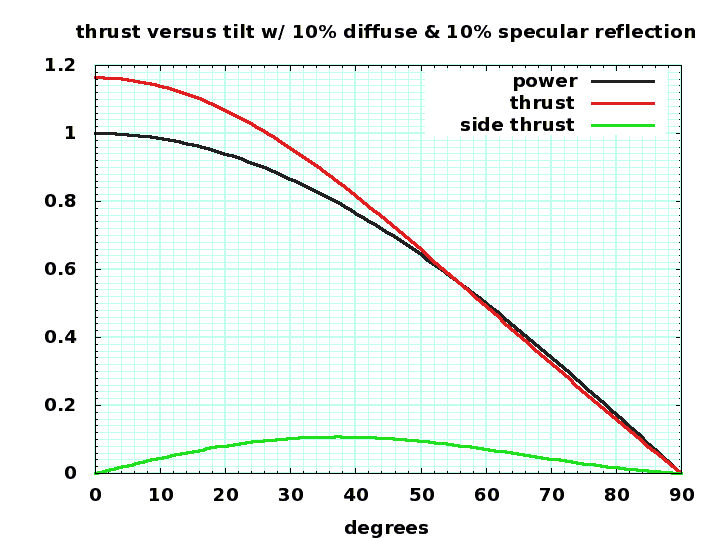
Drag and Ballistic Coefficient
The first planned thinsat constellations are in the m288 orbit, at an altitude of 6408 km. The atmosphere is very thin at that altitude, so drag will be negligible. However, thinsats (or fragments of them) may find themselves at lower altitudes, so the ballistic coefficient is needed to compute the decay of their orbits. The worst case ballistic coefficient is probably that of a flat plate moving face-on into the airstream, and the best case is edge-on. Lets assume the average resembles a sphere of the same radius (drag coefficient of 2), as it will probably be tumbling end over end. For a 9 cm disk weighing 7 grams, the ballistic coefficient is 0.15 kg/m2, about 30% of the Echo communication balloon.
At the altitude of Teledesic and Globalstar, about 1400km, the mean atmospheric density is around 7.1E-15 kg/m3. The decay rate at that altitude will be about 4km/year; the velocity change needed to maintain orbit would be about 4 meters/second/year, or 0.12 microns/second/second. A thinsat can do that, with some maneuvering and perhaps some additional specular albedo added to the sun-side.
Magnetic attitude control
Anon123 writes: Because a thinsat is so light, it ought also to be possible to use the Earth's magnetic field for attitude control. Circulating 1 Ampere of current around the thinsat's rim will produce on the order of 0.1 μN*m sin(angle between local magnetic field direction and the normal to thinsat) of torque, which applied to a 3g thinsat will produce an angular acceleration on the order of 0.01rad/s². The direction of the torque cannot be controlled as such, but after a quarter-orbit the magnetic field vector's direction will be roughly orthogonal to its previous direction. When the rim loop is not being used for torquing, it can measure local magnetic field strength by induced EMF. This data may be useful for both navigation and science.
- It might even be possible to do away with the optical shutters altogether, making production simpler and cheaper.
KeithLofstrom responds Thinsats are in equatorial orbits, and the earth's dipole field is mostly perpendicular to that orbit. Magnetic torque is \vec B \times \vec I , so there cannot be torque in the direction of the B field. Unfortunately, that is the direction of torque most needed for a thinsat, both to compensate for tidal forces and to perform night light pollution avoidance orientation. Optical light shutters are a feature, not a drawback - the electro-chromic material is cheap, fast, easy to deposit, and draws only microamps of current and only while switching states. The back EMF from a five minute turn in a milli-gauss field is quite small, and would likely be swamped by thermal noise without a very precise measurement system (which are difficult to design and calibrate in a radiation bath).
Your point about measurement is a good one, though. It may be possible to build a very thin flux-gate magnetometer chip for measuring B fields, and some small arrays of scientific thinsats might incorporate these and other sensors. Navigation will require far more accuracy than variations in the magnetic field will provide. Spacing will be measured to micron accuracy with radio beam time of flight, orbital position by GPS, ground based radio, and radar measurements of LAGEOS and other geodynamic satellites. Thank you for your comments.
updated for Version 0.2, half-sized thinsats.

